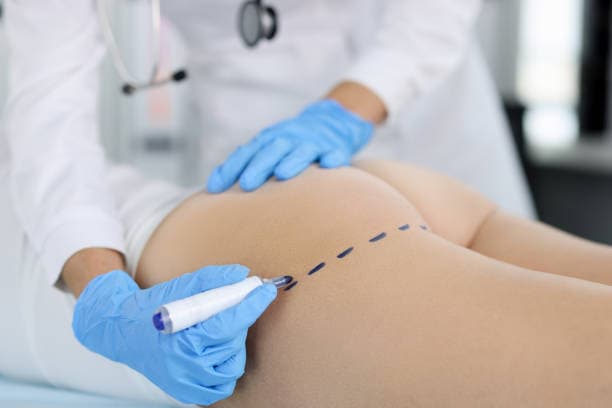Buttock enhancement procedures, often referred to as gluteal augmentation, are designed to improve the size, shape, and contour of the buttocks. By understanding each step of the buttock enhancement procedure, patients can make informed decisions and achieve their desired aesthetic outcomes.
Buttock Enhancement Steps
A buttock enhancement procedure typically begins with an in-depth consultation with a board-certified plastic surgeon to discuss the patient's goals and determine the most appropriate method, whether it be fat grafting (Brazilian Butt Lift), silicone implants, or a combination of both. Pre-operative preparations include medical evaluations, adjusting lifestyle habits such as avoiding smoking, and following detailed instructions provided by the surgeon. On the day of the surgery, the patient is administered anesthesia to ensure comfort throughout the procedure. During fat grafting, the surgeon performs liposuction to remove fat from other areas of the body, which is then purified and injected into the buttocks to achieve the desired shape and volume. For silicone implants, the surgeon creates precise incisions to place the implants within the buttocks. After the procedure, post-operative care involves specific guidelines for activity restrictions, wearing compression garments to support healing, and attending follow-up appointments to monitor progress and address any concerns. By meticulously following these steps, patients can achieve natural-looking and satisfying results from their buttock enhancement procedure.
Step 1 – Anesthesia
The anesthesia step in a buttock enhancement procedure is crucial for ensuring patient comfort and safety. On the day of the surgery, the patient is typically administered general anesthesia, which induces a deep sleep-like state, rendering them unconscious and pain-free throughout the operation. This is administered by an anesthesiologist, who carefully monitors the patient's vital signs, including heart rate, blood pressure, and oxygen levels, to ensure stability during the procedure. In some cases, local anesthesia combined with sedation may be used, depending on the extent of the surgery and the patient's medical history. The choice of anesthesia is determined during the pre-operative consultation, where the surgeon and anesthesiologist assess the patient's overall health and discuss the best option for their specific needs. The anesthesia step not only ensures a painless surgical experience but also facilitates a smoother and more controlled procedure, allowing the surgeon to focus on achieving the best possible results.

Step 2 – The incision
The incision step in a buttock enhancement procedure is a critical phase where precision and technique come to the forefront. Depending on the chosen method, either fat grafting or silicone implants, the incisions are strategically placed to minimize visible scarring and ensure optimal results. For fat grafting, small, discreet incisions are made at the liposuction sites to harvest fat, and additional tiny incisions are created in the buttocks to inject the purified fat. For silicone implants, the surgeon makes incisions in well-concealed areas such as the crease between the buttocks or the gluteal fold. These incisions are carefully planned to access the targeted area while maintaining the natural contour of the buttocks. The surgeon meticulously creates pockets to position the implants securely, ensuring symmetry and a natural appearance. Throughout this step, the surgeon’s expertise in handling tissues and minimizing trauma is crucial for promoting smooth recovery and achieving aesthetically pleasing results. Post-operative care involves closely following the surgeon’s instructions to ensure proper healing of the incision sites and reduce the risk of complications.

Step 3 – Implant placement
The implant placement step in a buttock enhancement procedure is a meticulous process that significantly impacts the final aesthetic outcome. During this phase, the surgeon creates carefully planned incisions in well-concealed areas, such as the crease between the buttocks or the gluteal fold. These incisions allow access to the precise locations where the silicone implants will be positioned. The surgeon meticulously creates pockets within the gluteal muscles or between the muscle and fascia, ensuring that the implants are securely placed for a natural and symmetrical appearance. The surgeon's expertise is crucial in this step, as proper implant placement is essential for achieving the desired contour and avoiding complications. Once the implants are positioned, the incisions are closed with sutures, and the area is bandaged to support the healing process. Post-operative care includes following specific guidelines to prevent movement of the implants and promote optimal recovery. This step is pivotal in enhancing the buttocks' shape and achieving a harmonious, balanced look.

Step 4 – Closing the incisions
The closing of incisions in a buttock enhancement procedure is a meticulous step that ensures the surgical wounds heal properly and minimize scarring. After the implants are securely placed or the fat grafting process is completed, the surgeon carefully sutures the incisions. These sutures may be placed in layers, starting with the deeper tissues and moving outward to the skin, to provide strong support for the healing tissues and help maintain the newly contoured shape. The surgeon may use absorbable sutures that dissolve over time or non-absorbable ones that will need to be removed during a follow-up visit. In some cases, adhesive strips or surgical glue may be applied to further secure the skin. After closing the incisions, the surgeon will apply dressings and compression garments to protect the area, reduce swelling, and support the healing process. Proper care and hygiene of the incision sites are crucial to prevent infection and promote optimal recovery. By diligently following post-operative care instructions, patients can ensure that their incisions heal well and contribute to a successful outcome of their buttock enhancement procedure.

Step 5 – Seeing the results
Seeing the final results of a buttock enhancement procedure is an exciting and rewarding step for patients. After weeks or months of healing, the swelling and bruising gradually subside, revealing the new, contoured shape of the buttocks. Patients often feel a sense of satisfaction and confidence as they notice the enhanced curves and improved symmetry achieved through the procedure. It’s important to remember that the final results may take several months to fully manifest, as the body continues to adapt and heal. Regular follow-up appointments with the surgeon allow for close monitoring of the progress and ensure that the results align with the patient’s expectations. Patients are encouraged to maintain a healthy lifestyle, including proper diet and regular exercise, to preserve the results and enjoy their enhanced appearance for years to come. The journey to the final reveal is one of patience and dedication, ultimately leading to a boost in self-esteem and body confidence.

Conclusion
In conclusion, the journey through a buttock enhancement procedure involves a series of meticulous steps designed to ensure safety, precision, and optimal results. From the initial consultation and pre-operative preparations to the anesthesia, incision, implant placement, and final closure, each phase is crucial in achieving the desired outcome. The procedure culminates with the patient seeing the final results after a period of careful recovery and healing. Following post-operative care instructions diligently and attending follow-up appointments are essential for a smooth recovery and long-lasting results. The combined expertise of the surgeon and the patient’s commitment to their recovery journey ultimately led to enhanced contours and boosted confidence.
Read More